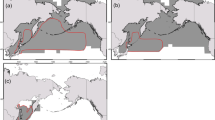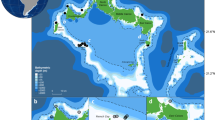Abstract
It is becoming increasingly evident that jellyfish (Cnidaria: Scyphozoa) play an important role within marine ecosystems, yet our knowledge of their seasonality and reproductive strategies is far from complete. Here, we explore a number of life history hypotheses for three common, yet poorly understood scyphozoan jellyfish (Rhizostoma octopus; Chrysaora hysoscella; Cyanea capillata) found throughout the Irish and Celtic Seas. Specifically, we tested whether (1) the bell diameter/wet weight of stranded medusae increased over time in a manner that suggested a single synchronised reproductive cohort; or (2) whether the range of sizes/weights remained broad throughout the stranding period suggesting the protracted release of ephyrae over many months. Stranding data were collected at five sites between 2003 and 2006 (n = 431 surveys; n = 2401 jellyfish). The relationship between bell diameter and wet weight was determined for each species (using fresh specimens collected at sea) so that estimates of wet weight could also be made for stranded individuals. For each species, the broad size and weight ranges of stranded jellyfish implied that the release of ephyrae may be protracted (albeit to different extents) in each species, with individuals of all sizes present in the water column during the summer months. For R. octopus, there was a general increase in both mean bell diameter and wet weight from January through to June which was driven by an increase in the variance and overall range of both variables during the summer. Lastly, we provide further evidence that rhizostome jellyfish may over-wintering as pelagic medusa which we hypothesise may enable them to capitalise on prey available earlier in the year.





Similar content being viewed by others
References
Arai, M. N., 1997. A functional biology of Scyphozoa. Chapman & Hall, London.
Arai, M. N., 2001. Pelagic coelenterates and eutrophication: a review. Hydrobiologia 451: 69–87.
Båmstedt, U., H. Ishii & M. B. Martinussen, 1997. Is the scyphomedusa Cyanea capillata dependent on gelatinous prey for its early development. Sarsia 82: 269–273.
Beaugrand, G., K. M. Brander, A. Lindley, S. Souissi & P. C. Reid, 2003. Plankton effect on cod recruitment in the North Sea. Nature 426: 661–664.
Brewer, R. H., 1989. The annual pattern of feeding, growth, and sexual reproduction in Cyanea (Cnidaria: Scyphozoa) in the Niantic River estuary, Connecticut. Biological Bulletin of the Marine Biological Laboratory, Woods Hole 176: 272–281.
Brierley, A. S., B. E. Axelsen, E. Buecher, C. A. J. Sparks, H. Boyer & M. J. Gibbons, 2001. Acoustic observations of jellyfish in the Namibian Benguela. Marine Ecology Progress Series 210: 55–66.
Brierley, A. S., D. C. Boyer, B. E. Axelsen, C. P. Lynam, C. A. J. Sparks, H. J. Boyer & M. J. Gibbons, 2005. Towards the acoustic estimation of jellyfish abundance. Marine Ecology Progress Series 295: 105–111.
Buecher, E., C. Sparks, A. Brierley, H. Boyer & M. Gibbons, 2001. Biometry and size distribution of Chrysaora hysoscella (Cnidaria, Scyphozoa) and Aequora aequora (Cnidaria, Hydrozoa) off Namibia with some notes on their parasite Hyperia medusarum. Journal of Plankton Research 23: 1073–1080.
Chen, J. & G. Ding, 1983. Effect of temperature on the strobilation of edible medusa, Rhopilema esculenta Kishinouye Scyphozoa, Rhizostomeae). Acta Zoologia Sin 29: 195–206.
Conover, R. J., 1988. Comparative life histories in the genera Calanus and Neocalanus in high latitudes of the northern hemisphere. Hydrobiologia 167–168: 127–142.
Cushing, D. H., 1990 Plankton production and year-class strength in fish populations: an update of the match/mismatch hypothesis. Advances in Marine Biology 26: 249–292.
Ding, G. W. & J. K. Chen, 1981. The life history of Rhopilema esculenta Kishinouye. Journal of Fisheries, China 5: 93–102.
Doyle, T. K., J. D. R. Houghton, S. M. Buckley, G. C. Hays & J. Davenport, 2006. The distribution of five scyphozoan jellyfish species across a temperate coastal environment. Hydrobiologia 579: 29–39.
Doyle, T. K., J. D. R. Houghton, R. McDevitt, G. C. Hays & J. Davenport, 2007. The energy density of jellyfish: estimates from bomb-calorimetry and proximate-composition. Journal of Experimental Marine Biology and Ecology, DOI: 10.1016/j.jembe.2006.12.010.
Edwards, M., A. W. G. John, H. G. Hunt & Lindley J. A., 1999. Exceptional influx of oceanic species into the North Sea late 1997. Journal of the Marine Biological Association of the United Kingdom 79: 737–739.
Frid, C. L. J., L. C. Newton & J. A. Williams, 1994. The feeding rates of Pleurobrachia (ctenophore) and Sagitta (chetognatha) with notes on the seasonal role of planktonic predators in the dynamics of North Sea zooplankton communities. Aquatic Ecology 28: 181–191.
Harris, R. P., X. Irigoien, R. N. Head, C. Rey, B. H. Hygum, B. W. Hansen, B. Niehoff, B. Meyer-Harms & F. Carlotti, 2000. Feeding, growth and reproduction in the genus Calanus. ICES Journal of Marine Science 57: 1708–1726.
Hay, S. J., J. R. G. Hislop & A. M. Shanks, 1990. North Sea scyphomedusae: summer distribution, estimated biomass and significance particularly for O-group gadoid fish. Netherlands Journal of Sea Research 25: 113–130.
Hays, G. C., A. J. Richardson & C. Robinson, 2005. Climate change and marine plankton. Trends in Ecology & Evolution 20: 337–344.
Heath, M. R., J. G. Fraser, A. Gislason, S. J. Hay, S. H. Jonasdottir & K. Richardson, 2000. Winter distribution of Calanus finmarchicus in the northeast Atlantic. ICES Journal of Marine Science 57: 1628–1635.
Hernroth, L. & F. Gröndahl, 1983. On the biology of Aurelia aurita (L.): 1. Release and growth of Aurelia aurita (L.) ephyrae in the Gullmarfjorden, western Sweden. Ophelia 22: 189–199.
Hernroth, L. & F. Gröndahl, 1985. On the biology of Aurelia aurita (L.): 2. Major factors regulating the occurrence of ephyrae and young medusae in the Gullmarfjorden, western Sweden. Bulletin of Marine Science 37: 567–576.
Houghton, J. D. R., T. K. Doyle, J. Davenport & G. C. Hays, 2006a. Jellyfish aggregations and leatherback turtle foraging patterns in a temperate coastal environment. Ecology 98: 1967–1972.
Houghton, J. D. R., T. K. Doyle, J. Davenport & G. C. Hays, 2006b. Developing a simple, rapid method for identifying and monitoring jellyfish aggregations from the air. Marine Ecology Progress Series 314: 159–170.
Hirche, H. J., 1983. Overwintering of Calanus finmarchicus and C. helgolandicus. Marine Ecology Progress Series 11: 281–290.
Irigoien, X., 2004. Some ideas about the role of lipids in the life cycle of Calanus finmarchicus. Journal of Plankton Research 26: 259–263.
Kawahara, M., S.-I. Uye, K. Ohtsu & H. Lizumi, 2006. Unusual population explosion of the giant jellyfish Nemopilema nomurai (Scyphozoa: Rhizostomeae) in East Asian waters. Marine Ecology Progress Series 307: 161–173.
Kingsford, M. J., K. A. Pitt & B. M. Gillanders, 2000. Management of jellyfish fisheries, with special reference to the Order Rhizostomeae. Oceanography and Marine Biology 38: 85–156.
Lotan, A., M. Fine & R. Ben-Hillel, 1994. Synchronization of the life cycle and dispersal pattern of the tropical invader scyphomedusan Rhopilema nomadica is temperature dependent. Marine Ecology Progress Series 109:59–65.
Lucas, C. H. & S. Lawes, 1998. Sexual reproduction of the scyphomedusa Aurelia aurita in relation to temperature and variable food supply. Marine Biology 131:629–638.
Lucas, C. H., 2001. Reproduction and life history strategies of the common jellyfish, Aurelia aurita, in relation to its ambient environment. Hydrobiolgia 451: 229–246.
Lynam, C. P., S. J. Hay & A. S. Brierley, 2004. Interannual variability in abundance of North Sea jellyfish and links to the North Atlantic Oscillation. Limnology and Oceanography 49: 637–643.
Lynam, C. P., S. J. Hay & A. S. Brierley, 2005. Jellyfish abundance and climatic variation: contrasting responses in oceanographically distinct regions of the North Sea, and possible implications for fisheries. Journal of the Marine Biological Association of the United Kingdom 85: 435–450.
Lynam, C. P., M. J. Gibbons, B. E. Axelsen, C. A. J. Sparks, J. Coetzee, B. G. Heywood & A. S. Brierley, 2006. Jellyfish overtake fish in a heavily fished ecosystem. Current Biology 16(13): R492.
Möller, H., 1980. Population dynamics of Aurelia aurita medusae in Kiel Bight, Germany (FRG). Marine Biology 60:123–128.
Möller, H., 1984. Reduction of larval herring population by jellyfish predator. Science 224: 621–622.
Mills, C. E., 1995. Medusae, siphonophores and ctenophores as planktivorous predators in changing global ecosystems. ICES Journal of Marine Science 52: 575–581.
Mills, C. E., 2001. Jellyfish blooms: are populations increasing globally in response to changing ocean conditions. Hydrobiologia 451: 55–68.
Omori, M., 1981. Edible jellyfish (Scyphomedusae: Rhizostomeae) in the Far East waters: a brief review of the biology and fishery. Bulletin of the Plankton Society of Japan 28: 1–11.
Omori, M., H. Ishii & A. Fujinaga, 1995. Life history strategy of Aurelia aurita (Cnidaria, Scyphomedusae) and its impact on the zooplankton community of Tokyo Bay. ICES Journal of Marine Science 52: 597–603.
Omori, M. & E. Nakano, 2001. Jellyfish fisheries in Southeast Asia. Hydrobiologia 451: 19–26.
Pauly, D., V. Christensen, J. Dalsgaard, R. Froese & F. Torres, 1998. Fishing down marine food webs. Science 279: 860–863.
Parsons, T. R., M. Takahashi & B. Hargrave, 1983. Biological Oceanographic Processes. Pergamon Press, Oxford.
Pérez-Ruzafa, A., J. Gilabert, J. M. Gutiérrez, A. I. Fernández, C. Marcos & S. Sabah, 2002. Evidence of a planktic food web response to changes in nutrient input dynamics in the Mar Menor coastal lagoon, Spain. Hydrobiologia 475/476: 359–369.
Purcell, J. E., 1991. A review of cnidarians and ctenophores feeding on competitors in the plankton. Hydrobiologia 216/217: 335–342.
Purcell, J. E., 2005. Climate effects on formation of jellyfish and ctenophore blooms: a review. Journal of the Marine Biological Association of the United Kingdom 85: 461–476.
Purcell, J. E & M. N. Arai, 2001. Interactions of pelagic cnidarians and ctenophores with fish: a review. Hydrobiologia 451: 27–44.
Purcell, J. E., J. R. White, D. A. Nemazie & D. A. Wright, 1999. Temperature, salinity and food effects on asexual reproduction and abundance of the scyphozoan Chrysaora quinquecirrha. Marine Ecology Progress Series 180: 187–196.
Rasmussen, E., 1973. Systematics and ecology of the Isefjord marine fauna (Denmark). Ophelia 11: 41–46.
Reid, P. C., M. Edwards, H. G. Hunt & A. J. Warner, 1998. Phytoplankton change in the northern Atlantic. Nature 391: 546.
Russell, F. S., 1970. The Medusae of the British Isles. II. Pelagic Scyphozoa with a Supplement to the First Volume on Hydromedusae. Cambridge University Press, Cambridge: 284.
Sugiura, Y., 1966. On the life history of rhizostome medusae. 4. Cephea cephea. Embryologia 9:105–122.
Sims, D. W., E. J. Southall, A. J. Richardson, P. C. Reid & J. D. Metcalfe, 2003. Seasonal movements and behaviour of basking sharks from archival tagging: no evidence of winter hibernation. Marine Ecology Progress Series 248: 187–196.
Acknowledgements
Funding was provided by: (1) INTERREG IIIA (European Regional Development Fund); (2) the Countryside Council for Wales Species Challenge Fund (3) the Marine Conservation Society; (4) National Parks and Wildlife Service (Ireland) and (5) The Marine Institute (Ireland). Special thanks to David Jones, Vincent, Sean and Christina Rooney, Jim and Rose Hurley, Kevin McCormack, Eithne Lee, Maria Doyle, Kate Williamson, Irena Kruszona and colleagues, Vernon Jones, Tom Stringell, Ailish Murphy and Irene Fitzgerald and everyone else who assisted with the shoreline surveys.
Author information
Authors and Affiliations
Corresponding author
Additional information
Handling editor: K. Martens
Rights and permissions
About this article
Cite this article
Houghton, J.D.R., Doyle, T.K., Davenport, J. et al. Stranding events provide indirect insights into the seasonality and persistence of jellyfish medusae (Cnidaria: Scyphozoa). Hydrobiologia 589, 1–13 (2007). https://doi.org/10.1007/s10750-007-0572-2
Received:
Revised:
Accepted:
Published:
Issue Date:
DOI: https://doi.org/10.1007/s10750-007-0572-2




